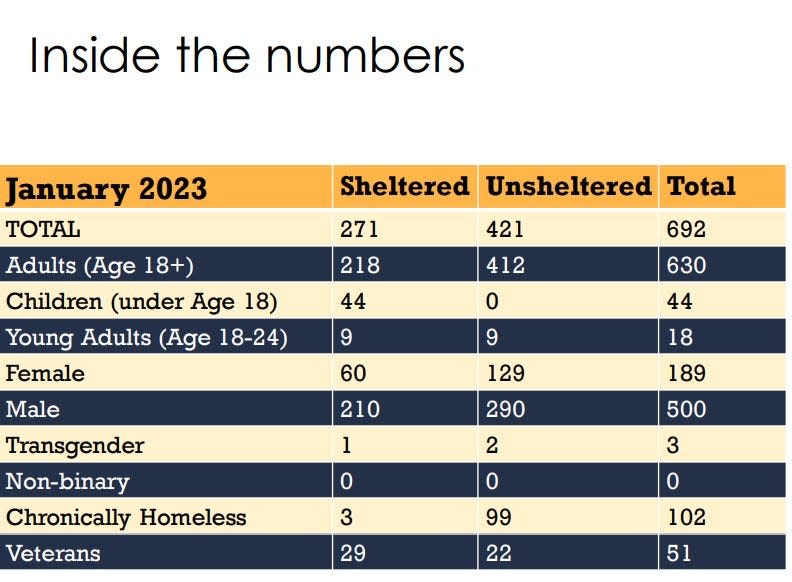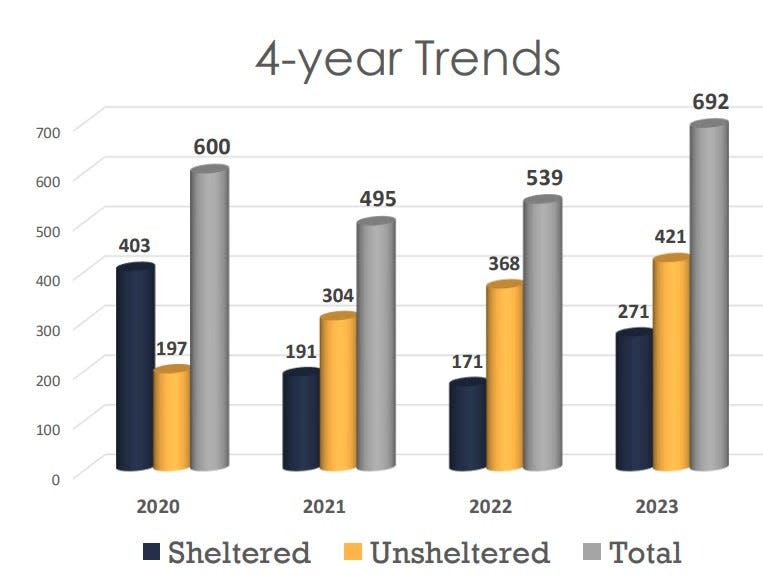Homeless population rises in latest Amarillo Point-in-Time count
The city of Amarillo announced that the homeless population had increased in number during its latest Point-in-Time (PIT) count that was conducted in January.
A PIT count is a 24-hour survey of the homeless population in an effort to get a measure of the number of homeless people on a specific day. The city can get a snapshot of its approximate homeless population with this count. Amarillo conducts two of these counts each year, one in the winter and one in the summer.
The data is then used to inform governmental agencies from city to federal levels and to gauge the effectiveness of programs and policies. This data can affect funding and support for the Amarillo continuum of care.

A total of 692 people were counted as homeless in the new PIT count, with 421 of those individuals being unsheltered. This is an increase in 153 homeless and 53 unsheltered individuals from the 2022 survey.
Among the homeless population, 630 are of adult age and 44 are considered minors. On this PIT count, none of the 44 minors were considered unsheltered. The homeless population is predominantly male, with only 189 of the 692 homeless counted being female.
Veterans made up a relatively low number of the homeless in Amarillo, with 51 identifying themselves as such. Of those homeless veterans, 22 were unsheltered. The number could skew slightly higher or lower, since the unsheltered self-identified as veterans while most who have shelter have been documented as veterans.
More:Homeless Heroes holds meeting with Willow Creek residents to address concerns, questions
This year’s count of the homeless population is higher than any recent count since 2020, and the city hopes that its Transformation Park concept that will break ground this spring can impact unsheltered homeless and help to provide solutions and assistance to those experiencing homelessness.
Jason Riddlespurger, director of community development of Amarillo, addressed the Amarillo City Council Tuesday with the results of its recent homeless population survey.
“So we went up about 150, and it’s unfortunate. We don’t like for the numbers to go up, but we were anticipating that they were going up based on our outreach teams that are out,” Riddlespurger said. “They have seen that it looks like there are many more people, and the numbers from our Point-in-Time count confirm that.”
Riddlespurger said that some of the factors that are contributing to more homeless in the city are the effects of COVID-19, rent costs and the general cost of food, which has left people more susceptible than ever.

“I think, really, the housing costs and rental rates have really risen in the recent past, and I know that COVID has had a big problem for some of our folks that are out there,” he continued. “We need more affordable housing. We need rent to be stable. We need people to start to get, be able to own their homes.”
According to Riddlespurger, many of the public perceptions of the homeless population are quite misunderstood, and in reality, being out on the street is a much greater danger to those experiencing homelessness than the population that perceives them as being the dregs of society.
“We do not want people having to live out on the streets, which is a dangerous option for those forced to live in these dangerous places,” Riddlespurger said.
He said that one of the issues for many people who are experiencing these issues is knowing where to get help and finding out more information to help with their predicament. Riddlespurger recommended the Guyon Saunders Resource Center located at 200 S. Tyler St. as a valuable resource for those in the community facing financial and shelter issues.
More:Amarillo gets public input on Transformation Park plan
Asked about the impact that the Transformation Park might have on reducing the homeless population in the city, Riddlespurger emphasized that this would eliminate many of the barriers that keep the homeless out of many of the other local shelters. Many of the barriers can include mental health issues and if they have a pet, which most shelters do not allow them to bring them in.
Riddlespurger said the research that has been done on options and looking at other cities make the city’s homeless plan a viable solution to reduce homelessness in Amarillo. The Transformation Park will be equipped with about 60 individual cabins, which can accommodate two people per cabin, and overall, the facility will be able to house about 200 people.
Acknowledging that the shelter would not be able to accommodate all the unsheltered in the city, Riddlespurger said that at this point, the limitation is the land at hand for the site, but overall, the city will explore every option available to get those in need shelter.
“We want to connect these people to solutions to their homeless situation,” Riddlespurger said. “These are people that many have been through trauma, and we want to help them get through this and help find solutions. I have made many friends that have overcome this struggle in my work, and I want to do my best to help them.”
The Transformation Park is expected to take about 18 months to be completed.
This article originally appeared on Amarillo Globe-News: Homeless population rises in latest Amarillo Point-in-Time count

